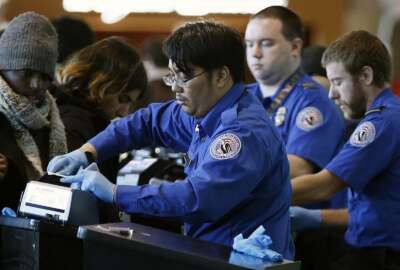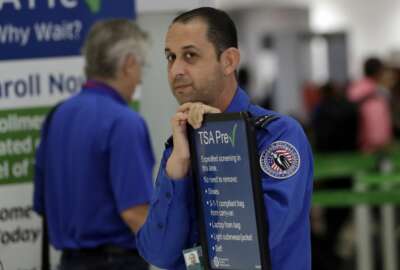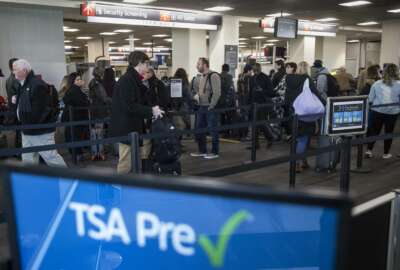
TSA finishes work on a nifty new training center in the west
For the Transportation Security Administration, what happens in Las Vegas certainly does not stay there. TSA recently opened a new officer training center near the...
For the Transportation Security Administration, what happens in Las Vegas certainly does not stay there. TSA recently opened a new officer training center near the Las Vegas Airport, and new hires trained there take their knowledge all over the country. For an update, Federal Drive Host Tom Temin spoke with TSA’s Assistant Administrator of Training and Development, Kim Hutchinson.
Interview Transcript:
Tom Temin So this grand opening was the second of two training centers, correct?
Kim Hutchinson That’s right. We’ve got two big training centers that host our training for our newest employees, what we call our basic training program.
Tom Temin All right. And tell us about the basic training program for TSOs, transportation security officers. It looks kind of simple when you see them externally, but there’s a lot going on there, isn’t there?
Kim Hutchinson Absolutely. Yes. So you can imagine it’s a pretty intense training program. It really does take place over the course of a new hire, a new transportation security officers, maybe first six months on the job. So we kind of chunk it out in a couple of parts. So it really actually starts at your local airport, which we call phase one. And that’s where you really kind of you know, you get your airport ID and you really learn about what’s going on locally. You do some training on some of the technology, but really not the advanced stuff. Once you’ve mastered that and let’s say 2 to 3 months time, you go to one of TSA’s academies, and that’s the TSA Academy West, the new one we’re talking about today. Once you do that again, you get another three weeks in training. The first week actually happens at your home station, but it’s piped out of our academy. So it’s taught by instructors, just like we’re talking now in a WebEx setting. And that’s where really we talk a lot about what it means to be a TSA employee, what it means to be a DHS employee, the culture of TSA. Because you can imagine some of our newest offers didn’t experience 9-11. So we want them to understand why their job is so critical in protecting the traveling public, what our mission is and so on. And they kind of preview some of the procedures. And then right after that, that week at that local airport, they head to either TSA Academy West, which is located very close to Las Vegas Airport or TSA Academy East, which is in coastal Georgia on the federal Law Enforcement Training center. So really, it kind of depends on where you live, what training center you go to, even though you could go to either one. But generally, we started up the West Coast Training Center to be more convenient for our employees coming from, say, the islands from California. You can imagine it’s a really long trip to get to coastal of Georgia from say Guam. And we really wanted our officers to be ready to experience this really intense training program. So I think it really gets to, you know, the convenience for our employees as well as just kind of student ready readiness.
Tom Temin And at the regional training centers, at Training Center West, then it’s residential. They’re there and living there for the duration.
Kim Hutchinson They sure are. They’re living in a hotel. They’re all together for two weeks.
Tom Temin Got it. And it sounds like from the way you describe the basic training, there’s as much human relations and cultural inculcation as technical, because when you think about it, TSOs really their toughest job is human relations.
Kim Hutchinson Absolutely. I think to really be a good TSO like in many other jobs, you have to be a great communicator. And many times you don’t really have a lot of knowledge on what’s going on with that passenger before they hit the checkpoint. Right. So you’re going to experience all kinds of passengers. You’re going to experience the business, the seasoned business traveler who’s been through that airport a million times. You might be experiencing a first time traveler. It might be a teenager or a grandparent that hasn’t gotten on a plane in a while. So really what we teach at the academies is how to deal with every possible passenger you receive, you know, at your checkpoints.
Tom Temin And how versatile do you want TSOs to be? I’m thinking, you know, just as a flier like everybody else visible to the public, there’s at least eight discreet functions, you know, between the time you arrive until you get on the plane. But there’s a lot that goes on you don’t see. Correct. And the offices in the byways and labyrinths of the airports.
Kim Hutchinson That’s right. And I’m really I think you have to kind of take on that role of TSO when you walk in the door, when you get out of your car or your bus from the airport. Right. People are always engaging officers to say, well, where do I do? Where do I go, or what can I bring on the plane or do I have to check my bag? So it’s it’s almost beyond your job at the checkpoint. It really does include all those pieces. So I think that’s another piece to the Academy west where our officers are actually training in a checkpoint right next to a live checkpoint. So it’s not some kind of a simulated classroom environment. You’re literally, you know, you’re hearing the airport announcement and noise while you’re learning these these functions, which is much more realistic training environment to what your job is going to be.
Tom Temin We’re speaking with Kim Hutchinson. She’s Assistant Administrator and Chief Learning Officer for the Office of Training and Development at the TSA. To what extent are officers taught where they can use discretion? And here’s what I mean. A thing goes through the scanner and there’s lots of pictures of stuff. And obviously, if you see a pistol in there, well, you know, that raises the red flags and the person’s arrested, etc., etc.. But there are things that are not so clear cut. We’ve all experienced that use of discretion by officers. How do you teach them that particular skill?
Kim Hutchinson I think it starts with understanding the standard operating procedures, right? There are certain things you have discretion on and other things that you don’t. My answer to that would be, you know, you do have a big network of people at the checkpoint. So if you’re a new officer, say, coming out of training and you see something that you don’t think it’s a prohibited item, but you’re not sure, you know, that’s where we really teach this piece about you’re part of a bigger team, right? So we really do want officers to focus on threats, obviously. And if they’re not sure to make sure that they engage other passengers. So there’s discretion in some regards, but at the end of the day. SOP has to be followed. You’ve got a bunch of people around you to kind of help you get through the process.
Tom Temin And describe the new facility in Las Vegas. Where is it in relation to the airport and what’s in there? Is it mostly just spaces with desks and tables or what?
Kim Hutchinson It’s a very modern looking building from the outside. It’s 26,000 square foot facility. It’s got six classrooms, it’s got a couple of large multipurpose rooms. It’s got office space for our officers. And really, I think one of the neatest things about this facility is you can literally see the airport, the Tower of Las Vegas Airport, when you’re in a training room. So you can walk. I don’t recommend that, and especially this time of year, you know, it’s such a very close proximity. It’s less than a mile from the airport. So I think that’s another compelling thing. While you’re sitting there learning about what it means to be a TSO. So you can literally see planes taking off and on, which we haven’t experienced that at a training center before. So it’s really kind of magical having all those pieces come together at Academy West.
Tom Temin Yeah, it’s more interesting than that pyramid shaped hotel that’s kind of right there, almost at the end of the runway, I would say. I’d rather see planes than a pyramid shaped hotel. And is there testing throughout the process? In other words, do you have like bags made up of sample items and see if they catch things and they’re graded on that?
Kim Hutchinson Yes, absolutely. So just like any other, you know, classroom portion of training, you do have a couple of different tests. So our officers at the end of the two weeks, they go through a job knowledge test just to make sure they understand all the procedures, all the things they need to do when they’re doing this job. And then there’s an image test. So one of the core things we teach is X-ray. We spend a very good portion of this time looking at simulated images on a computer like we’re on now, but also looking at images at these real life checkpoints. You also have to take an image test, and if you need some assistance, we’ve got some remedial training on the ground. And then after you go through the two weeks, you go back to your your home airport and you will then really more integrate on the particular equipment that you have in your airport and then take one final image test before you get certified as a TSO. So there’s testing along the way.
Tom Temin Yeah, it’s interesting because the screening machines are kind of like rental cars. No two are precisely alike. I mean, there’s a bunch of different models of these things. And when new technology comes in, say, some of the body scanners that, you know, that obfuscate the human being, but show what’s in the pockets and so forth. How does that training get spread throughout the whole system as those machines get deployed?
Kim Hutchinson Yeah. So from the basic standpoint, we always try to have the latest equipment in our training checkpoints. So if you come from an airport that has this brand of CTE, that is the CTE that you will be trained on at at the academy. So that’s a wonderful thing. Now it’s a little different when it shows up at your airport, essentially when we know when airports are going to get so. Las Vegas Airport is getting a new machine, you know, CTE, whatever that may be. That’s when our officers get trained basically by trainers at the airport.
Tom Temin All right. And just a final question throughout a shift of a TSO, do they do the same thing for the entire time or do they shift from, you know, screening the people into the screening area or checking the the boarding pass, etc., to watching what’s going through in the scanners to whatever? Or do they rotate throughout the different jobs in a given shift?
Kim Hutchinson They do rotate. So you might start at that travel document checker where they look at your IDs and then move to the walk through, move to divestiture. So, yes, you know, basically every 20 to 30 minutes, an officer will take on a different position. So that’s just one of our challenges at the academies to really getting our officers competent in the expertise to do all of those things that you described.
Copyright © 2025 Federal News Network. All rights reserved. This website is not intended for users located within the European Economic Area.
Tom Temin is host of the Federal Drive and has been providing insight on federal technology and management issues for more than 30 years.
Follow @tteminWFED





